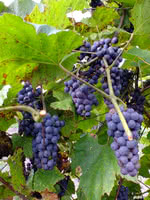Mon-Fri 9am - 5pm Mountain time
Black Elderberry vs Amur Grape
Vitis amurensis
Sambucus canadensis
NOT AVAILABLE THIS SEASON - MIGHT RETURN
NOT AVAILABLE THIS SEASON - MIGHT RETURN
The Amur Grape is an ornamental grape that fruits dark, sour, juicy grapes later in the fall. It is native to Asia, and found growing wild in Russia and China. It’s one of the most cold-hardy grape varieties, prized for its foliage that turns from a bright green to a deep crimson and purple in the fall. The flowers are small and white, usually appearing in the beginning of May.
The name for the Amur Grape comes from the Amur Valley, located in Russia. It’s extremely resistant to frost. The berries are good for fresh eating, but also make a flavorful addition to any homemade wines and preserves. The leaves are also edible, and are commonly used in salads. This plant does best with a trellis.
Note: We do not ship grape vines to BC due to regulatory restrictions from the Canadian Food Inspection Agency.
Black Elderberry is a deciduous shrub native to eastern North America. You can plant this shrub in moist areas and it will help stabilize your soil. You can also use it on rural properties anywhere you'd use a lilac.
Black Elderberries are considered to be partially self-pollinating. So while they will still produce some berries without cross-pollination, planting with another variety will increase yields. Consider planting with Ranch Elderberry or Bob Gordon Elderberry.
Warning: the seeds, stems, leaves, roots, and uncooked berries of the Black Elderberry are poisonous to humans when eaten in quantity. You should cook the berries to make them safe for human consumption.
Amur Grape Quick Facts
Black Elderberry Quick Facts
Toxicity: leaves, stems, and uncooked berries are poisonous to humans

